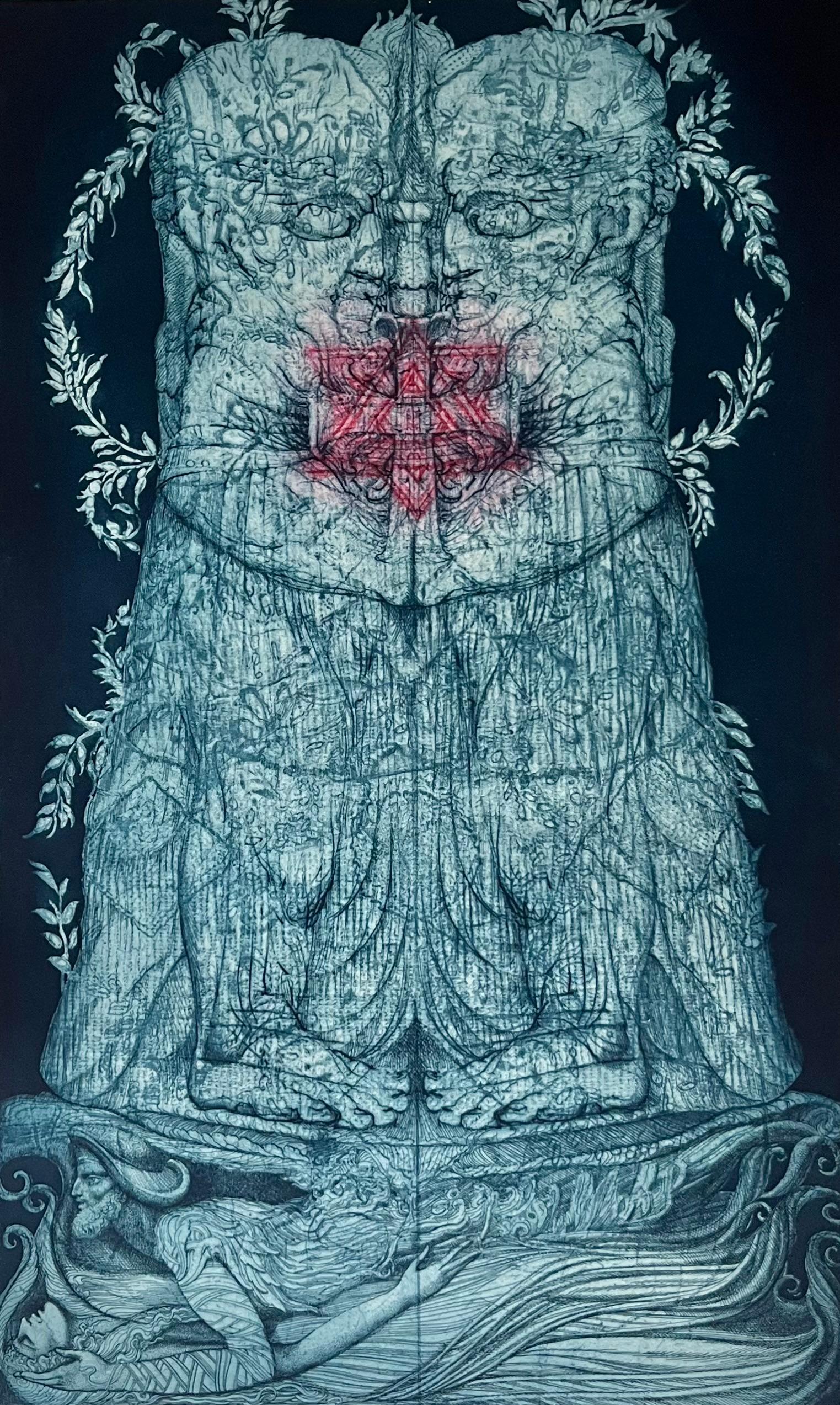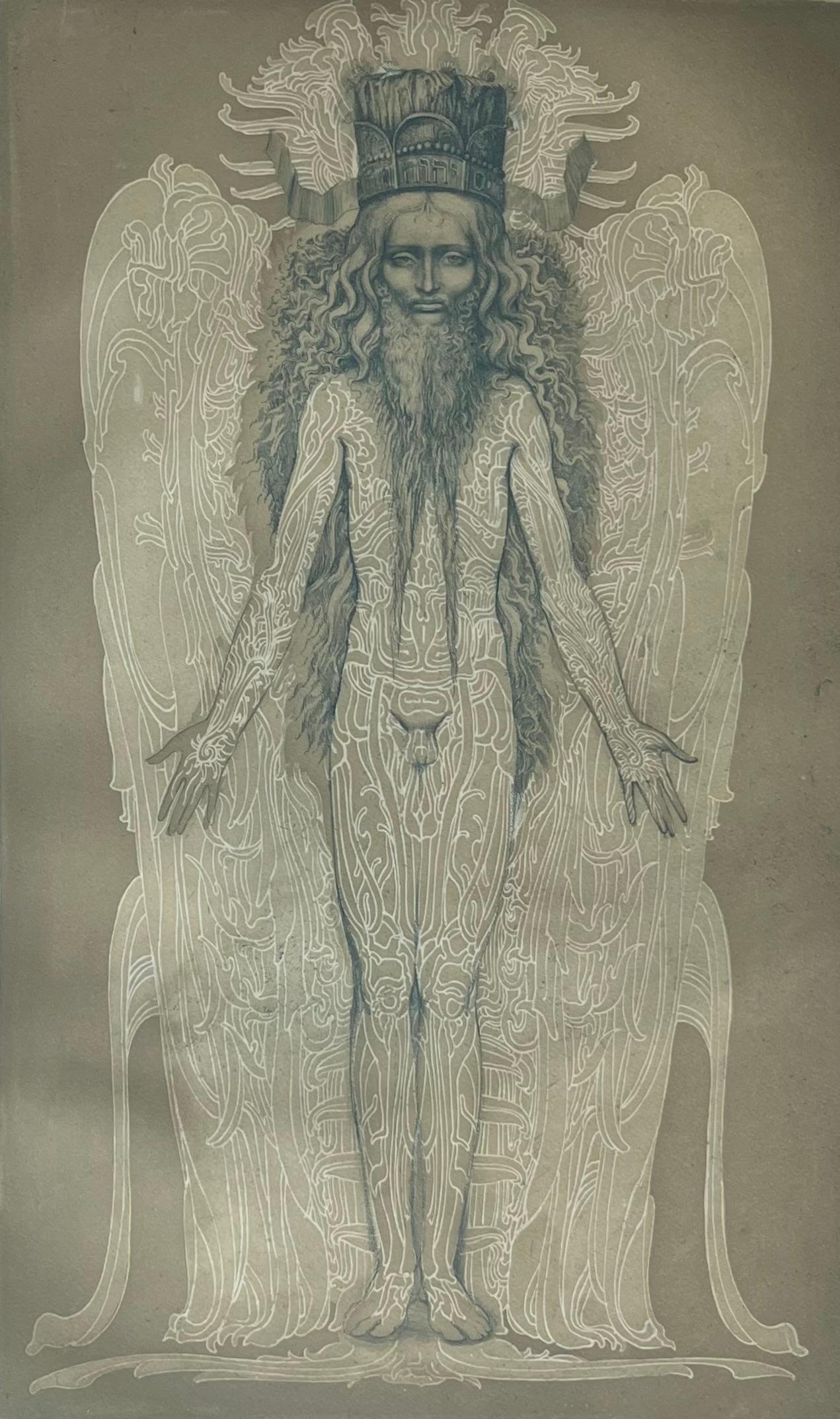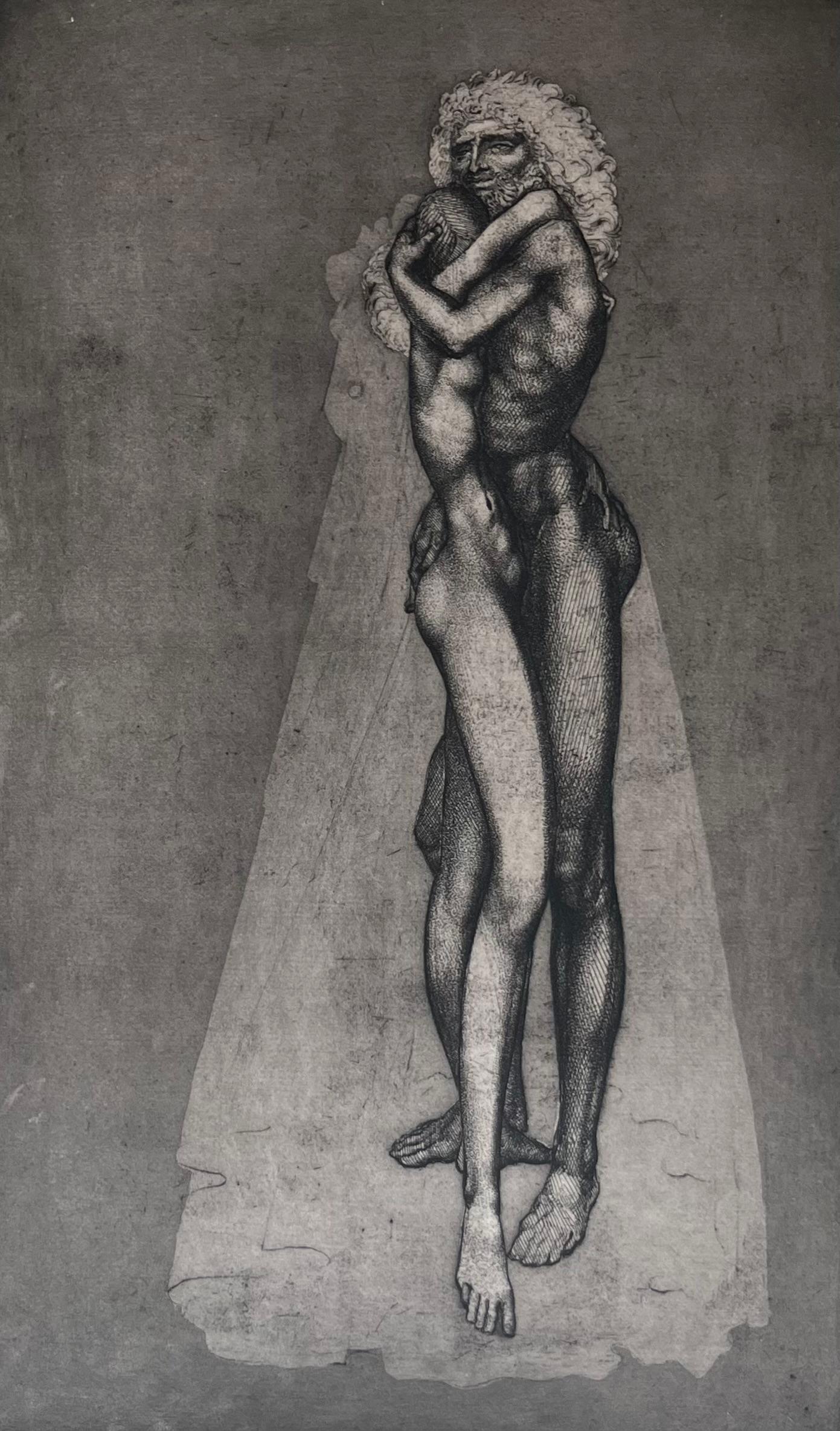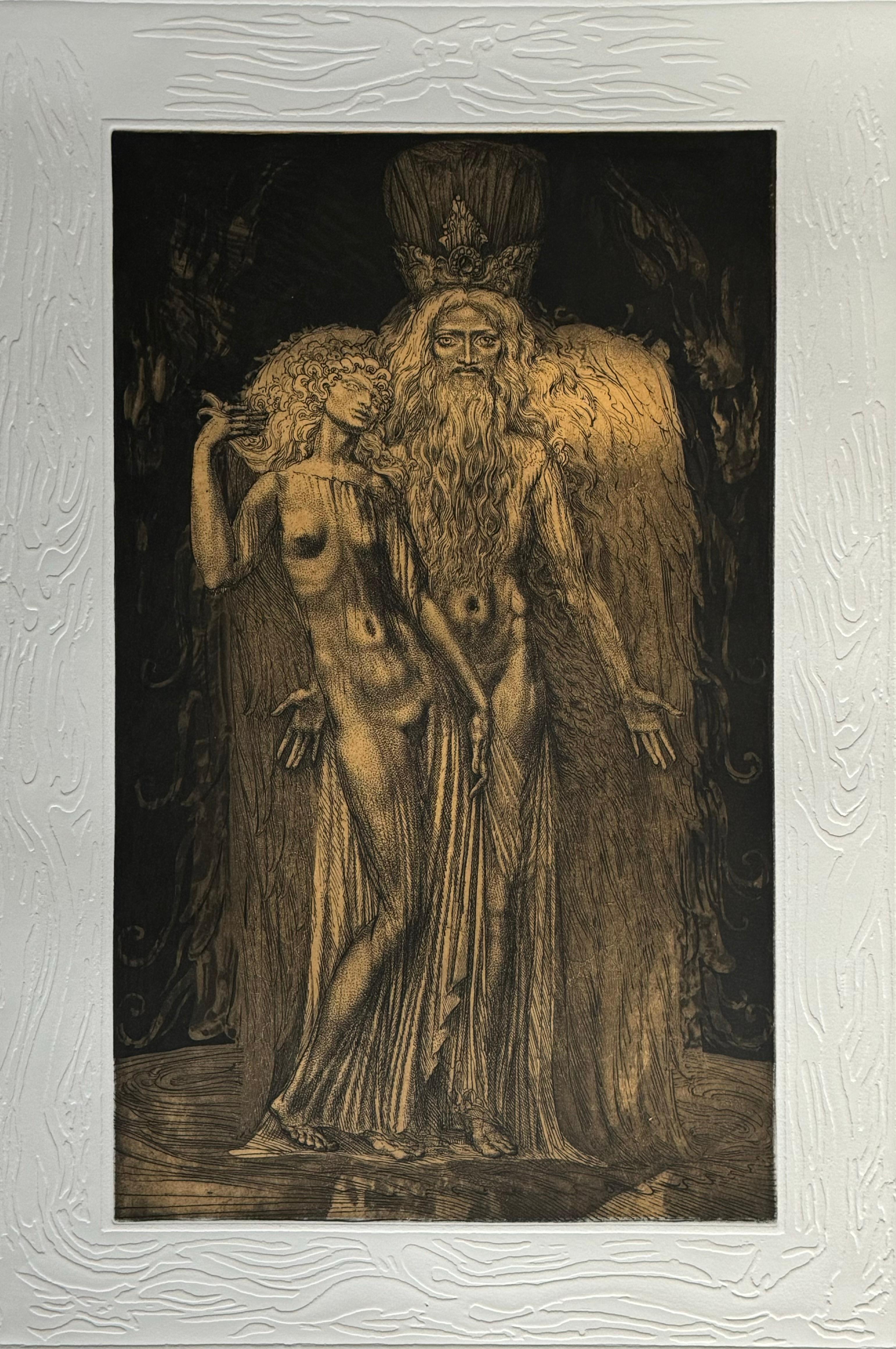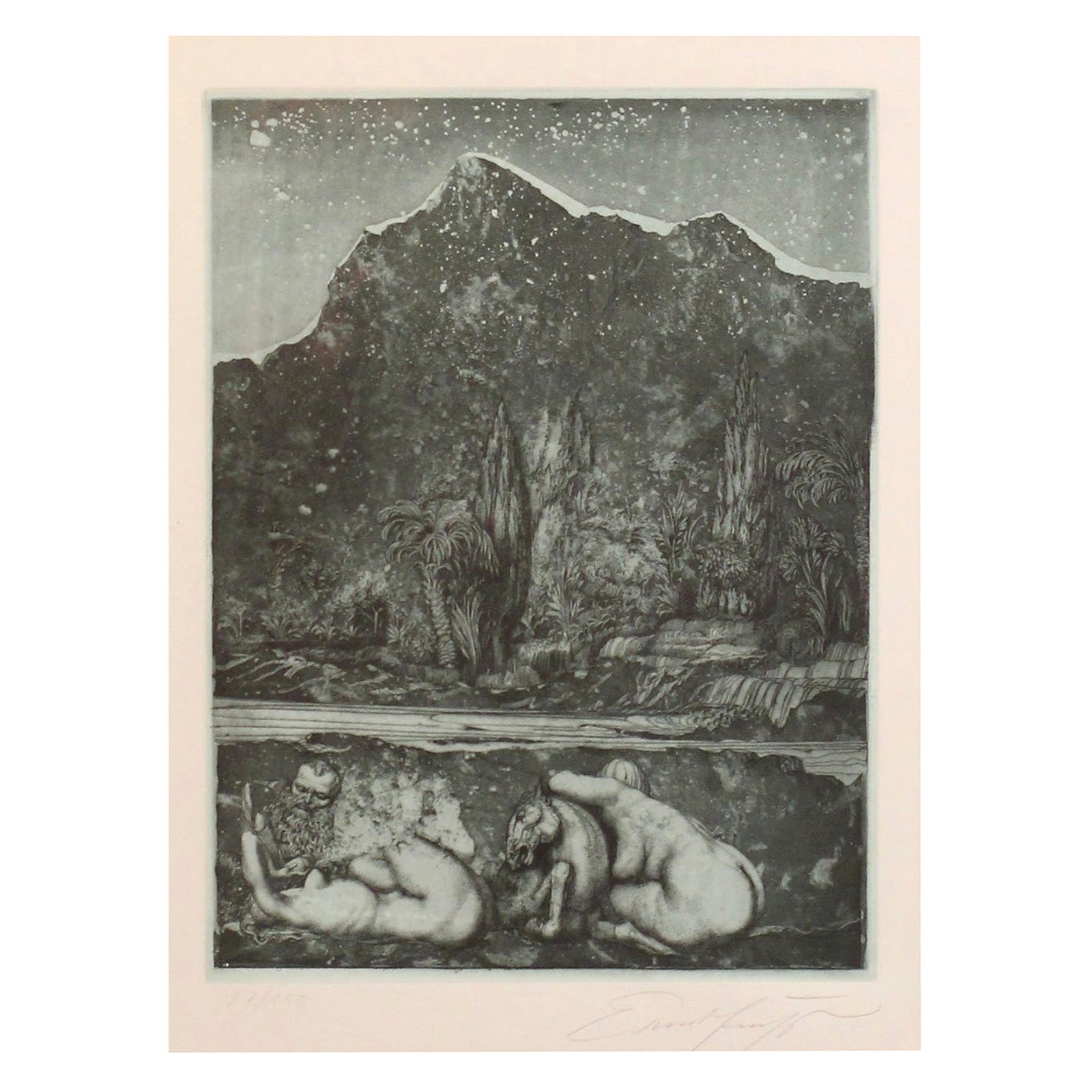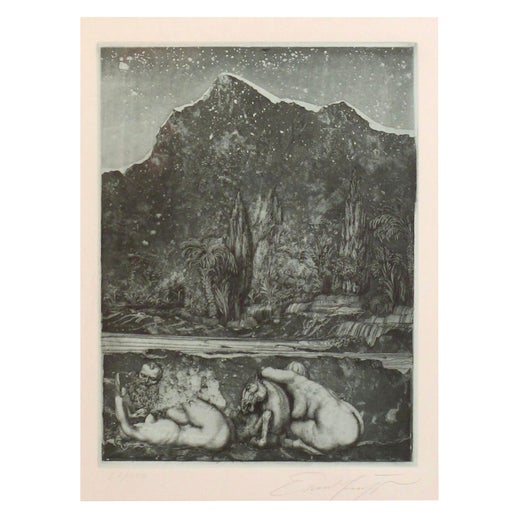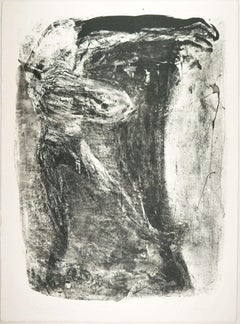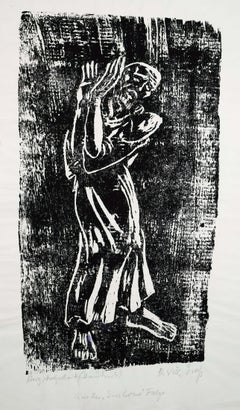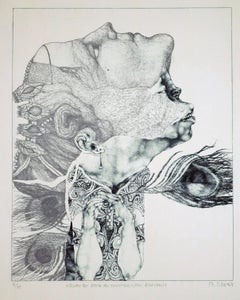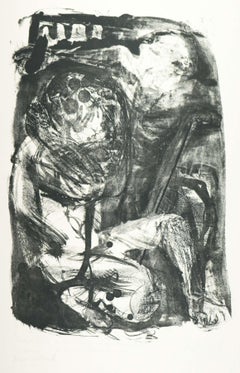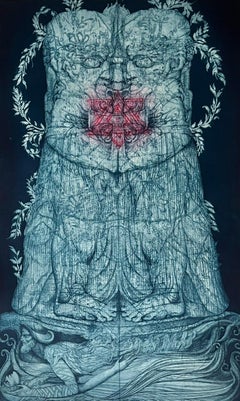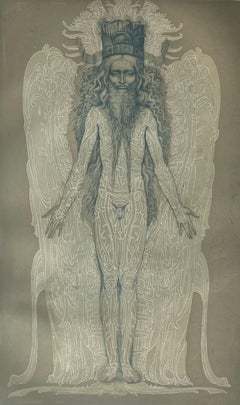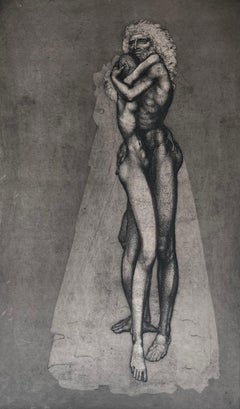Items Similar to The Lost Trace / - The Holy Night as a real dream -
Want more images or videos?
Request additional images or videos from the seller
1 of 12
Ernst FuchsThe Lost Trace / - The Holy Night as a real dream -1972
1972
$1,173.85
£878.06
€980
CA$1,617.51
A$1,778.04
CHF 933.46
MX$21,142.15
NOK 11,987.77
SEK 10,919.56
DKK 7,468.62
About the Item
Ernst Fuchs (1930 Vienna - 2015 ibid), The Lost Trace, 1972. Vernis mou and aquatint etching, 46.8 x 36.4 cm (plate), 66 x 50 cm (sheet), 69.5 x 53.5 cm (frame), WVZ Hartmann no. 185 Id, signed by hand in pencil at lower right Ernst Fuchs", numbered by hand II/XXV" at lower right and inscribed E.A. [Epreuvre d'Artist]". Paper with dry stamp. Framed behind glass.
- Few minimal crease marks in wide margin, frame with very occasional nudges.
- The Holy Night as a real dream -
Ernst Fuchs uses the printmaking technique of soft ground etching, also called "vernis mou", rediscovered by Félicien Rops in the 19th century. In this process, the printing plate, which is covered with a soft waxy layer, is covered with a paper on which the drawing is applied and pressed into the background. The result is a soft line and the transfer of the paper grain to the plate. Combined with aquatint etching, Fuchs achieved an extremely painterly effect with an intense flatness of color.
We are standing in a forest of Christmas trees at night. The burning candles combine with the twinkling stars and the white snowflakes to create a flurry of light that fills the night sky, while the snow, in turn, unfolds a white-blue luminosity. The face of Christ appears in the sky, with the wounds of the crown of thorns on his forehead. With his eyes closed, Christ seems to be dreaming the world. In the snow there are two faces, also with closed eyes, which form the surface of the world. The Christmas star literally falls on them. At Christmas, God does not appear alone above the world, he becomes present in the world itself, which Fuchs demonstrates through the immense footprint. He calls the graphic "The Lost Trace," but the trace in the picture does not disappear; it must be found and recognized, and then it also becomes clear that the trace is more than a trace; it is itself, as the steps of the hacking show, the path. The only path in the picture that leads to God as a motivic inversion of the ladder to heaven.
With his pictorial depiction of the Holy Night, Ernst Fuchs succeeds in illustrating the mediating event that redeems the world beyond conventional iconography in a way that is as inspiring as it is mysterious.
About the artist
The young Ernst Fuchs chose as his baptismal name 'Ernst Peter Paul', an homage by the then twelve-year-old to Peter Paul Rubens, who would continue to inspire him. He received his first art lessons from his godmother's brother, Alois Schiemann. Later he attended the St. Anna School of Painting in Vienna, and in 1946 he was admitted to the Vienna Academy of Fine Arts, where he studied until 1950 under Robin Andersen and Albert Paris Gütersloh, the intellectual father of the Viennese School of Fantastic Realism. After travelling extensively, Fuchs spent time at the Dormition Monastery on Mount Zion in Israel, where he became deeply involved in the iconography and spiritual painting techniques that influenced him. In his book Architectura Caelestis (1966), he states that many of his motif discoveries are based on visionary experiences, which he later emphasised:
“It is not uncommon for me to go into a trance while painting, my consciousness fading in favour of a medial suspended state in which I feel guided and moved by a sure hand, doing things of which I have little conscious knowledge. This state can sometimes last for several hours. Afterwards, everything I have created in this state seems to me as if someone else had done it.”
- Ernst Fuchs
In 1962 Fuchs returned to Vienna, was appointed professor at the Academy and became probably the most influential protagonist of the Viennese School of Fantastic Realism, which had presented its first group exhibition at the Belvedere in 1959. Apart from Ernst Fuchs, Arik Brauer, Rudolf Hausner, Anton Lehmden, Helmut Leherb and Gütersloh's son Wolfgang Hutter were the main representatives of this artistic movement.
In 1972 Fuchs acquired the Otto Wagner Villa, which he turned into his private museum in a congenial continuation of Viennese Art Nouveau. The 1970s also saw the development of an artistic friendship with Salvator Dalí and Arno Breker, which Dalí summed up in 1975 with the words: "We are the golden triangle of art: Breker-Dalí-Fuchs. You can rotate us any way you like, we are always on top".
Fuchs also confirmed himself as a singer of spiritual poetry and, from the 1990s onwards, devoted himself increasingly to his fantastic architecture. The idea of a total work of art that he pursued in the Otto Wagner Villa was also reflected in the design of everyday objects. A BMW 635 CSi, for example, became a "fire fox on a hare hunt" according to his design, and the Rosenthal porcelain factory produced numerous products based on his designs.
In his art, Ernst Fuchs draws from the abundance of tradition, from which his genius gives birth to a completely new semantics:
“Insights haunt me that I had not hoped to find. Grasped by this spirituality, I also understand what the great insights of other painters were that aroused my admiration. An understanding of art and the knowledge it conveys grips me, as if my mind had entered into a discourse with all artists of all epochs.”
- Ernst Fuchs
Selected Bibliography
Source texts
Ernst Fuchs: Architectura Caelestis - Images Of The Hidden Prime Of Styles (Die Bilder des verschollenen Stils), Frankfurt a. M. 1966.
ders.: Im Zeichen der Sphinx. Schriften und Bilder. Hrsg. v. Walter Schurian, München 1978.
ders.: Aura. Ein Märchen der Sehnsucht, München 1981.
ders.: Phantastisches Leben. Erinnerungen, Berlin 2001.
Catalog raisonné
Helmut Weis: Ernst Fuchs. Das graphische Werk. 1967 - 1980, München 1980.
Literature
Gerhard Habarta: Ernst Fuchs. Das Einhorn zwischen den Brüsten der Sphinx. Eine Biographie, Graz 2001.
Friedrich Haider (Hrsg.): Ernst Fuchs. Zeichnungen und Graphik aus der frühen Schaffensperiode mit Hinweisen auf die Malerei 1942-1959, Wien 2003.
Agnes Husslein-Arco (Hrsg.): Phantastischer Realismus. Arik Brauer, Ernst Fuchs, Rudolf Hausner, Wolfgang Hutter, Wien 2008.
GERMAN VERSION
Ernst Fuchs (1930 Wien - 2015 ebd.), Die verlorene Spur, 1972. Vernis mou und Aquatintaradierung, 46,8 x 36,4 cm (Plattengröße), 66 x 50 cm (Blattgröße), 69,5 x 53,5 cm (Rahmen), WVZ Hartmann Nr. 185 Id, in Blei rechts unten mit „Ernst Fuchs“ handsigniert, rechts unten mit „II/XXV“ handnummeriert und als „E.A. [Epreuvre d'Artist]“ bezeichnet. Papier mit Trockenstempel. Hinter Glas gerahmt.
- Im breiten Rand wenige minimale Knickspuren, der Rahmen mit sehr vereinzelten bestoßenen Stellen.
- Die Heilige Nacht als realer Traum -
Ernst Fuchs verwendet hier die druckgrafische Technik der im 19. Jahrhundert von Félicien Rops wiederdeckten Weichgrundätzung, die auch ‚Vernis mou‘ genannt wird. Bei diesem Verfahren wird die mit einer wachsweichen Beschichtung versehene Druckplatte mit einem Papier abgedeckt, auf welches die Zeichnung aufgetragen wird, die sich in den Untergrund eindrückt. Dies bewirkt einen weichen Strich und die Übertragung der Papierkörnung auf die Druckplatte. In Kombination mit der Aquatintaradierung erzeugt Fuchs eine äußerst malerische Wirkung mit einer intensiven Farbflächigkeit.
Wir stehen in einem nächtlichen Tannenwald aus Weihnachtsbäumen. Die brennenden Kerzen verbinden sich mit den funkelnden Sternen und den weißen Schneeflocken zu einem den Nachthimmel erfüllende Lichtgestöber, während der Schnee seinerseits eine weißbläuliche Leuchtkraft entfaltet. Am Himmel erscheint das Antlitz Christi mit den Einstichen der Dornenkrone auf der Stirn. Mit geschlossenen Augen scheint Christus die Welt zu träumen. Auch im Schnee sind zwei Gesichter mit ebenfalls geschlossenen Augen zu sehen, die in ihrer Tiefenerstreckung die Oberfläche der Welt bilden. Auf sie stürzt wortwörtlich der Weihnachtsstern hinab. Weihnachten erscheint Gott nicht allein über der Welt, er wird in der Welt selbst präsent, was Fuchs durch den immensen Fußabdruck vor Augen führt. Er nennt das Blatt ‚Die verlorene Spur‘, doch die Spur wird im Bild nicht verwehen, sie muss allerdings aufgefunden und erkannt werden, dann zeigt sich auch, dass die Spur mehr als eine Spur ist; sie ist selbst, wie es die Stufen des Hackens veranschaulichen, der Weg. Der einzige Weg im Bild, der als motivische Umkehrung der Himmelsleiter zu Gott führt.
Mit seiner bildlichen Darstellung der Heiligen Nacht gelingt es Ernst Fuchs, das die Welt erlösende Vermittlungsgeschehen jenseits der herkömmlichen Ikonografie auf eine ebenso inspirierende wie geheimnisvolle Weise zu veranschaulichen.
zum Künstler
Der junge Ernst Fuchs wählt als Taufnamen ‚Ernst Peter Paul‘, eine Reverenz des gerade einmal Zwölfjährigen an Peter Paul Rubens, der ihn immer wieder inspirieren sollte. Ein erster künstlerischer Unterricht wurde ihm durch den Bruder seiner Taufpatin, Alois Schiemann, zuteil. Später besuchte er die Malschule St. Anna in Wien und 1946 wurde er in die Wiener Akademie der bildenden Künste aufgenommen, wo er unter Robin Andersen und Albert Paris Gütersloh, dem geistigen Vater der Wiener Schule des Phantastischen Realismus bis 1950 studierte. Nach zahlreichen Reisen hielt sich Fuchs länger im Dormitio-Kloster am Berg Zion in Israel auf, wo er sich intensiv mit der ihn prägenden Ikonenmalerei und der damit verbundenen spirituellen Maltechnik beschäftigte. In seinem Buch Architectura Caelestis (1966) teilt er mit, dass viele seiner Motivfindungen auf visionären Erfahrungen basieren, was er später abermals hervorhebt:
„Nicht selten gelange ich während des Malens in Trance, mein Bewusstsein schwindet zugunsten eines medialen Schwebezustandes, in dem ich mich von sicherer Hand geführt und bewegt fühle, Dinge tuend, von denen ich bewußtermaßen wenig weiß. Dieser Zustand kann mitunter mehrere Stunden dauern. Danach erscheint mir alles, was ich in diesem Zustand geschaffen habe, als ob ein anderer es getan hätte.“
- Ernst Fuchs
1962 kehrte Fuchs nach Wien zurück, wurde zum Professor an der Akademie berufen und zum wohl einflussreichsten Protagonisten der Wiener Schule des phantastischen Realismus, die 1959 im Belvedere ihre erste Gruppenausstellung präsentiert hatte. Neben Ernst Fuchs waren Arik Brauer, Rudolf Hausner, Anton Lehmden, Helmut Leherb und Güterslohs Sohn, Wolfgang Hutter, Hauptvertreter dieser Kunstströmung.
1972 erwarb Fuchs die Otto-Wagner-Villa, die er in kongenialer Weiterführung des Wiener Jugendstils zu seinem Privatmuseum gestaltete. In den 70er Jahren entwickelte sich auch die Künstlerfreundschaft mit Salvator Dalí und Arno Breker, die Dalí 1975 in die Worte fasste: „Wir sind das Goldene Dreieck der Kunst: Breker-Dalí-Fuchs. Man kann uns wenden, wie man will, wir sind immer oben.“
Fuchs bestätigte sich auch als Sänger spiritueller Lyrik und widmete sich ab den 1990er Jahren zusehends seiner phantastischen Architektur. Die in der Otto-Wagner-Villa verfolge Idee eines Gesamtkunstwerks schlug sich auch in der Gestaltung von Gebrauchsgegenständen nieder. So wurde ein BMW 635 CSi nach seinem Entwurf zum „Feuerfuchs auf Hasenjagd" und die Porzellanmanufaktur Rosenthal fertige zahlreiche Produkte nach seinen Vorlagen an.
In seiner Kunst schöpft Ernst Fuchs aus der Fülle der Tradition, aus der sein Genius eine ganz neue Semantik gebiert:
„Erkenntnisse suchen mich heim, die zu finden ich gar nicht gehofft hatte. Von dieser Geistlichkeit erfasst, begreife ich auch, was die großen Erkenntnisse anderer Maler waren, die meine Bewunderung erregten. Ein Verständnis der Kunst und der Erkenntnis, die sie vermittelt, erfasst mich, so, als ob mein Geist mit allen Künstlern aller Epochen in einen Diskurs geraten wäre.“
- Ernst Fuchs
Auswahlbibliographie
Quelltexte
Ernst Fuchs: Architectura Caelestis - Images Of The Hidden Prime Of Styles (Die Bilder des verschollenen Stils), Frankfurt a. M. 1966.
ders.: Im Zeichen der Sphinx. Schriften und Bilder. Hrsg. v. Walter Schurian, München 1978.
ders.: Aura. Ein Märchen der Sehnsucht, München 1981.
ders.: Phantastisches Leben. Erinnerungen, Berlin 2001.
Werkverzeichnis
Helmut Weis: Ernst Fuchs. Das graphische Werk. 1967 - 1980, München 1980.
Literatur
Gerhard Habarta: Ernst Fuchs. Das Einhorn zwischen den Brüsten der Sphinx. Eine Biographie, Graz 2001.
Friedrich Haider (Hrsg.): Ernst Fuchs. Zeichnungen und Graphik aus der frühen Schaffensperiode mit Hinweisen auf die Malerei 1942-1959, Wien 2003.
Agnes Husslein-Arco (Hrsg.): Phantastischer Realismus. Arik Brauer, Ernst Fuchs, Rudolf Hausner, Wolfgang Hutter, Wien 2008.
- Creator:Ernst Fuchs (1930, Austrian)
- Creation Year:1972
- Dimensions:Height: 27.37 in (69.5 cm)Width: 21.07 in (53.5 cm)Depth: 1.19 in (3 cm)
- Medium:
- Movement & Style:
- Period:
- Condition:
- Gallery Location:Berlin, DE
- Reference Number:1stDibs: LU2438213084392
Ernst Fuchs
Ernst Fuchs was a very poliedric artist. He was a painter, draftsman, printmaker, sculptor, architect, stage designer, composer, poet, singer and one of the founders of the Vienna School of Fantastic Realism. In 1972, he acquired the derelict Otto Wagner Villa in Hütteldorf, which he restored and transformed. The villa was inaugurated as the Ernst Fuchs Museum in 1988.

About the Seller
5.0
Vetted Professional Seller
Every seller passes strict standards for authenticity and reliability
Established in 2014
1stDibs seller since 2023
23 sales on 1stDibs
- ShippingRetrieving quote...Shipping from: Berlin, Germany
- Return Policy
More From This Seller
View AllMy treasure, my sanctuary / - A Tortured Treasure -
Located in Berlin, DE
Johannes Heisig (*1953 Leipzig), "My treasure, my sanctuary" - To the Christmas Oratorio by Johann Sebastian Bach. Lithograph on strong yellowish laid paper with watermark, 53 x 39.5...
Category
1980s Abstract Expressionist Figurative Prints
Materials
Lithograph
The Prophet / - The Burden of the Prophet -
Located in Berlin, DE
Wilhelm Gross (1883 Schlawe - 1974 Oranienburg-Eden), The Prophet, c. 1955. Woodcut on thin laid paper, 43 cm x 23 cm (depiction), 61 cm x 43 cm (sheet size), signed “Dr. Wilh.[elm] Gross” in pencil lower right, inscribed “Orig.[inal] Holzschnitt (Handabdruck)” lower left and inscribed “Aus der ”Ecce homo“ Folge” in the center.
- The wide margin with traces of pressing due to the impression, the sitter's left foot with a small purple stain, otherwise in vibrant condition.
- The Burden of the Prophet -
The large-format woodcut shows a prophet figure that takes up almost the entire height of the sheet. However, instead of seeing something in the distance that is still hidden from our eyes - as is usual in depictions of prophets - the figure has raised his hands in a defensive gesture, as if the prophet is trying to ward off what he has seen. At the same time, however, the position of the arms is an acceptance of the inevitable, which only those who recognize what is to come will have to bear for the time being, which is why the figure in the painting - despite its size - appears almost solitary, alone and exposed to the burden of suffering.
In a manner reminiscent of the folds of medieval wooden sculptures...
Category
1950s Realist Figurative Prints
Materials
Paper
Under the mask of the Venetian girl / - Monstrous Reality -
By Reiner Schwarz
Located in Berlin, DE
Reiner Schwarz (*1940 Hirschberg), Under the mask of the Venetian girl, 1968. Lithograph, 30 cm x 24 (image), 59 cm x 42 cm (sheet size), signed “R.[einer] Schwarz” in pencil lower r...
Category
1960s Surrealist Figurative Prints
Materials
Paper
Threatening to defeat me once and for all / - A Christmas Pietà -
Located in Berlin, DE
Johannes Heisig (*1953 Leipzig), "Threatening to defeat me once and for all" - To the Christmas Oratorio by Johann Sebastian Bach. Lithograph on strong yellowish laid paper with wate...
Category
1980s Abstract Expressionist Figurative Prints
Materials
Lithograph
The Dirndl Model / - The strangeness of the homeland -
By Reiner Schwarz
Located in Berlin, DE
Reiner Schwarz (*1940 Hirschberg), The Dirndl Model, 1969. Lithograph, 33 cm x 26 (depiction), 59 cm x 42 cm (sheet size), signed “R.[einer] Schwarz” in pencil lower right, dated “[1...
Category
1960s Surrealist Figurative Prints
Materials
Paper
Blessed are the spiritually poor / - The Abundance of Poverty -
Located in Berlin, DE
Rudolf Nehmer (1912 Bobersberg - 1983 Dresden), Blessed are the spiritually poor, 1948. Woodcut on yellowish wove paper, 20 cm x 15 cm (image), 45 cm x 30 cm (sheet size), signed “Ru...
Category
1940s Realist Figurative Prints
Materials
Woodcut
You May Also Like
Engraving #12 by Ernst Fuchs: KABBALAH (SEFER YETSIRA and 32 PATHS OF WISDOM)
By Ernst Fuchs
Located in Cliffside Park, NJ
Original engraving #12 by Ernst FUCHS from Kabbalah (THIRTY-TWO PATHS OF WISDOM by SEFER YETZIRA), 1978
Etching signed and numbered 16/30 E.A.
Page size - 30 x 22 in 76 x 56 cm
Imag...
Category
1970s Modern Figurative Prints
Materials
Paper, Etching
Flora Okuli - Etching by Ernst Fuchs - Late 20th Century
By Ernst Fuchs
Located in Roma, IT
Flora Okuli is an original artwork realized by the Austrian artist Ernst Fuchs (1920-2015).
Aquatint etching. Signed and numbered by the artist on the lower margin.
Edition of 10.0...
Category
Late 20th Century Contemporary Figurative Prints
Materials
Etching, Aquatint
Engraving #3 by Ernst Fuchs: KABBALAH (SEFER YETSIRA and 32 PATHS OF WISDOM)
By Ernst Fuchs
Located in Cliffside Park, NJ
Original engraving #3 by Ernst FUCHS from Kabbalah (THIRTY-TWO PATHS OF WISDOM by SEFER YETZIRA), 1978
Etching signed and numbered 16/30 E.A.
Page size - 30 x 22 in 76 x 56 cm
Image...
Category
1970s Modern Figurative Prints
Materials
Paper, Etching
Engraving #13 by Ernst Fuchs: KABBALAH (SEFER YETSIRA and 32 PATHS OF WISDOM)
By Ernst Fuchs
Located in Cliffside Park, NJ
Original engraving #13 by Ernst FUCHS from Kabbalah (THIRTY-TWO PATHS OF WISDOM by SEFER YETZIRA), 1978
Etching signed and numbered 16/30 E.A.
Page size - 30 x 22 in 76 x 56 cm
Imag...
Category
1970s Modern Figurative Prints
Materials
Paper, Etching
Engraving #1 by Ernst Fuchs: KABBALAH (SEFER YETSIRA and 32 PATHS OF WISDOM)
By Ernst Fuchs
Located in Cliffside Park, NJ
Original engraving #7 by Ernst FUCHS from Kabbalah (THIRTY-TWO PATHS OF WISDOM by SEFER YETZIRA), 1978
Etching signed and numbered 16/30 E.A.
Page size - 30 ...
Category
1970s Modern Figurative Prints
Materials
Paper, Etching
Ernst Fuchs 'Under the Snow Lilith' Print, 1969
By Ernst Fuchs
Located in Los Angeles, CA
Surreal dry point etching, 'Under the Snow Lilith' by Ernst Fuchs, signed lower left, right, numbered '27/150,' mounted and framed, panel size: 10.5" x 13.5" (without frame).
Category
Vintage 1960s German Mid-Century Modern Prints
Materials
Paper
